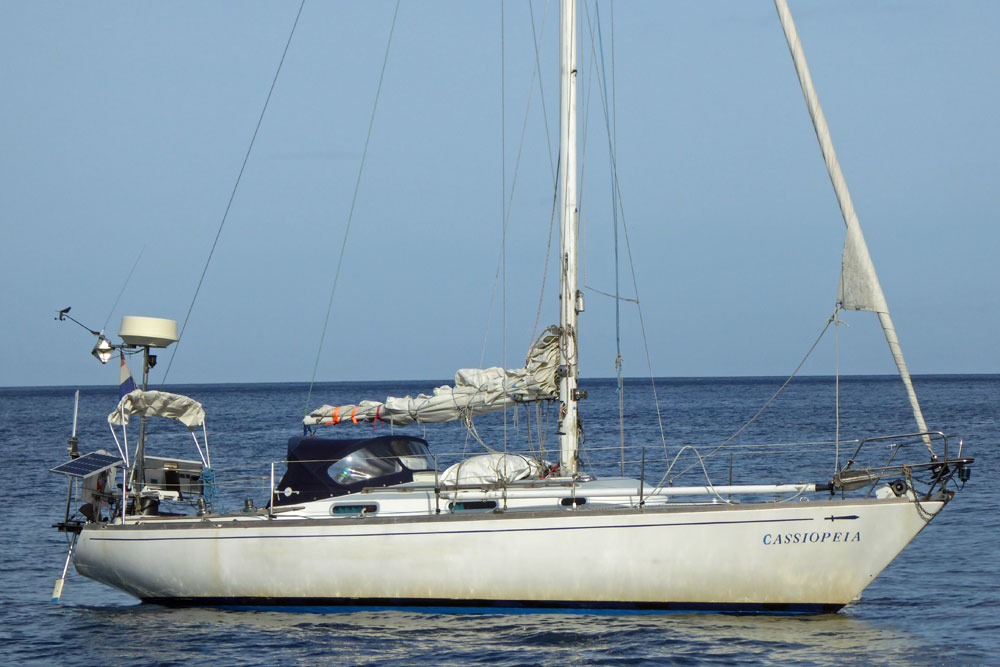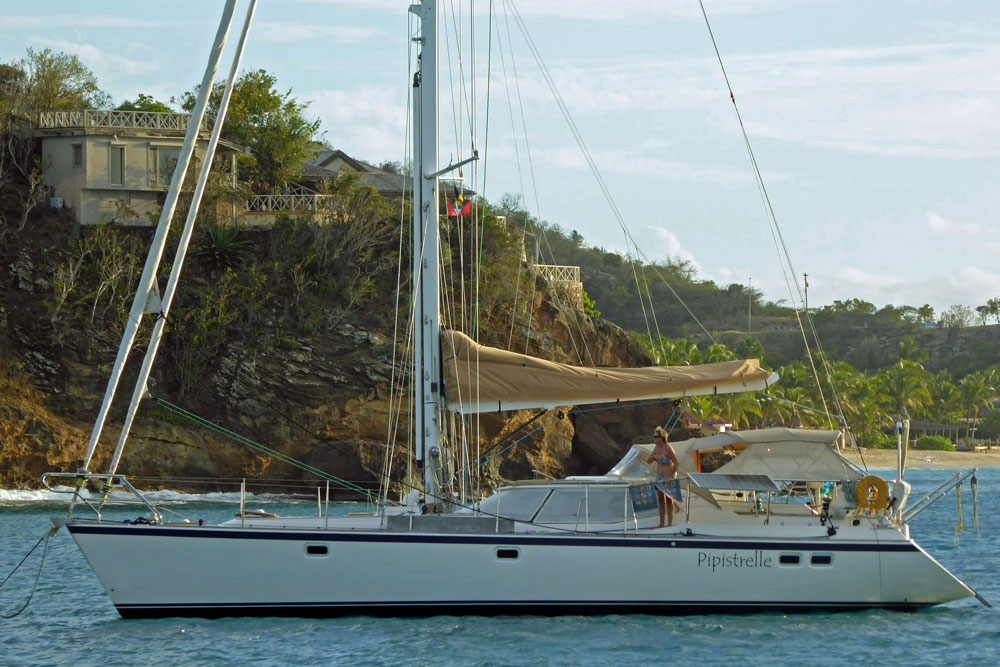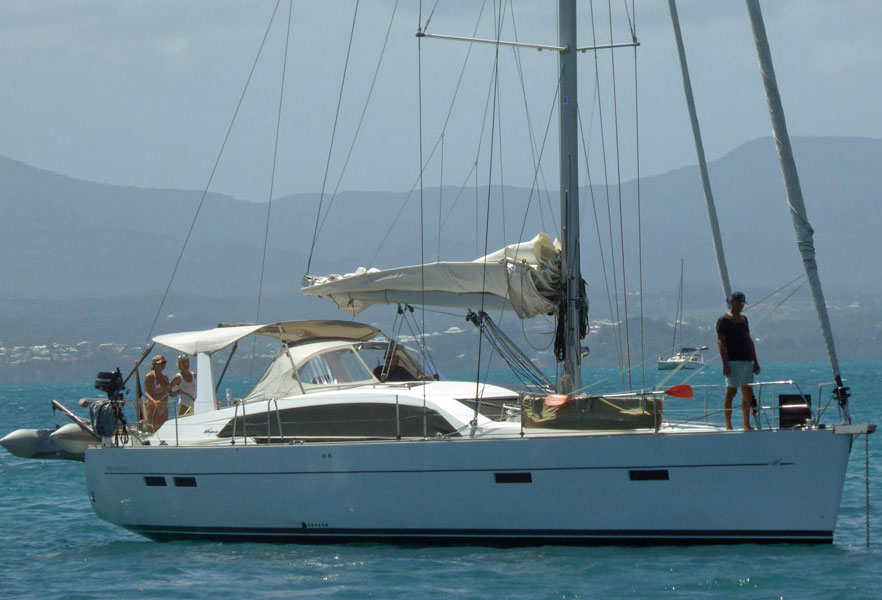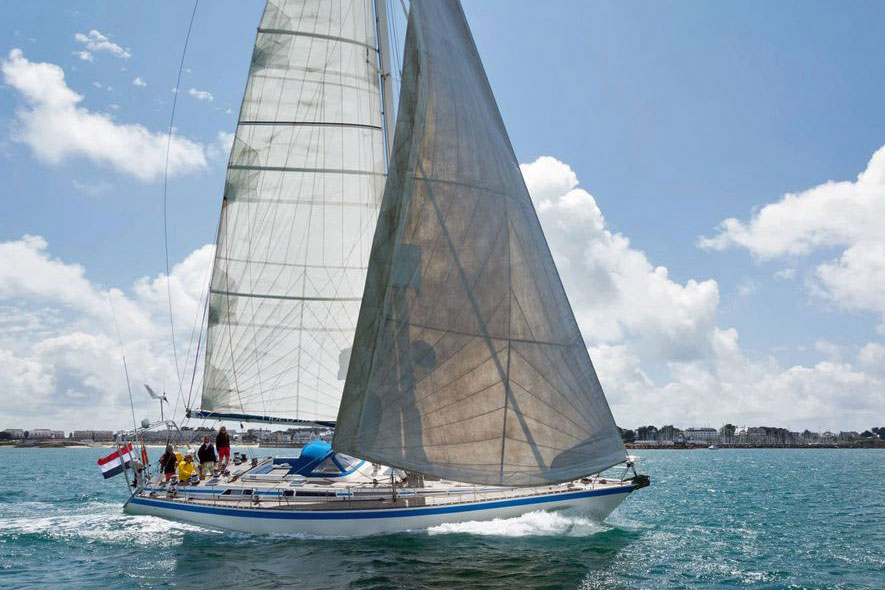- Home
- Cruising Yachts 35' to 40'
- Wauquiez Centurion 40 Sailboat
The Wauquiez Centurion 40 Sailboat
Specs & Key Performance Indicators
The Wauquiez Centurion 40, and aft-cockpit masthead sloop, was designed by Ed Dubois and constructed by the French shipyard Wauquiez, whose premises are located in Neuville-en-Ferrain, France.
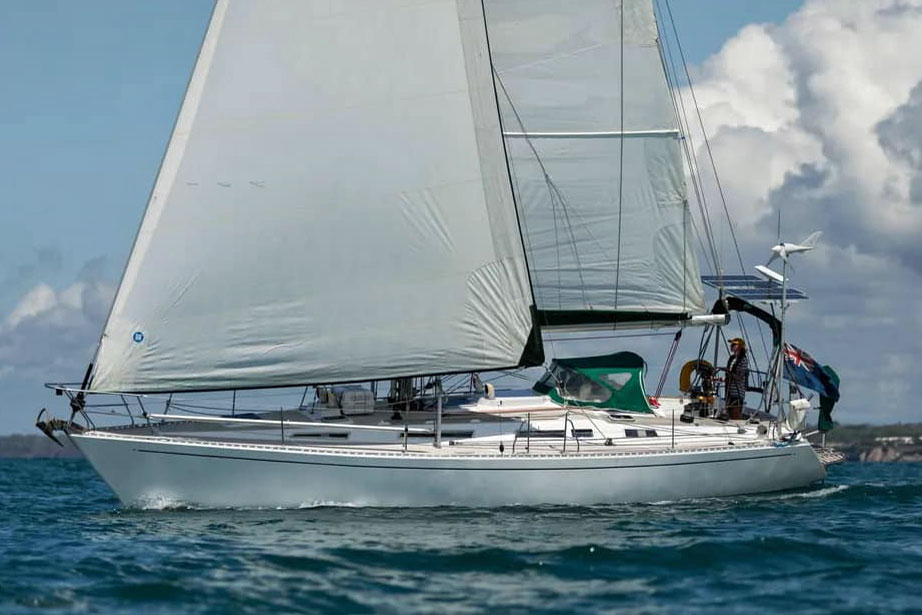 A Wauquiez Centurion 40 making good progress in light airs
A Wauquiez Centurion 40 making good progress in light airsPublished Specification for the Wauquiez Centurion 40 Sailboat
Keel & Rudder Configuration: Fin keel with spade rudder
Hull Material: Fiberglass
Length Overall (LOA): 12.5m (41'0")
Waterline Length (LWL): 10.5m (34'6")
Beam: 3.95m (13'0")
Draft: 2.3m (7'6")*
Rig Type: Masthead Sloop
Displacement: 8,500kg (18,739lb)
Ballast: 3,300 kilograms (7,275)
Designer: Ed Dubois
Builder: Wauquiez
Year First Built: 1988
Year Last Built: 1999
Number Built: Approximately 120 units
* The Centurion 40 was produced with either a deep lead keel with a draught of 7' 6" draught, or a shallow lead bulbed keel with a draught of 5' 3".
There was a later version of the Wauquiez Centurion 40 sailboat produced, specifically the Wauquiez Centurion 40S. Here are the essential differences between the original and the later version:
Wauquiez Centurion 40 (1988-1993):
- Keel Options: Deep lead keel (2.3 meters draft) or shallow lead bulbed keel (1.6 meters draft).
- Rig Type: Masthead sloop.
- Displacement: 8,500 kilograms.
- Ballast: 3,300 kilograms.
- Interior Layout: Practical and comfortable accommodations with a spacious saloon, well-equipped galley, and multiple berths.
Wauquiez Centurion 40S (2003-2007):
- Keel Options: Similar to the original, with deep and shallow draft options.
- Rig Type: Masthead sloop with options for racing enhancements such as rod rigging and a hydraulic backstay tensioner.
- Displacement: Slightly lighter at around 7,600 kilograms.
- Ballast: Approximately 2,760 kilograms.
- Interior Layout: Updated with more modern materials and design elements, maintaining a focus on comfort and functionality.
Published Design Ratios for the Wauquiez Centurion 40 Sailboat
The Key Performance Indicators (KPIs)
- A Sail Area/Displacement Ratio of 23.4 suggests that the Wauquiez Centurion 40 has relatively high performance. This means the boat should be able to accelerate well and perform competitively, especially in lighter wind conditions. It's a boat designed to have a good power-to-weight ratio, making it responsive and potentially faster compared to boats with lower ratios.
- With a Ballast/Displacement Ratio of 37.9, the Wauquiez Centurion 40 is likely to be reasonably stiff, though not the stiffest. Boats with a ratio of 40 or more are considered stiffer and can stand up better to the wind, but at 37.9, this sailboat would still handle average conditions well. However, it’s important to note that this ratio doesn’t account for ballast placement. If this boat has a deep keel with ballast concentrated low and at the foot of the keel, it could still exhibit excellent stiffness.
- The Displacement/Length Ratio of 265 indicates that this boat falls into the "Moderate Displacement" category. Such boats balance performance and comfort. They won't be as quick to reach hull speed as light displacement boats but will offer a steadier and more comfortable ride than ultralight boats. Moderate displacement is a good compromise for a performance-oriented cruiser.
- A Comfort Ratio of 29.3 suggests that the Centurion 40 is designed as a coastal cruiser with moderate stability. It should handle reasonably well in typical coastal conditions and provide a comfortable ride for most sailors under those circumstances. For extended bluewater cruising, a higher comfort ratio would be more desirable, but 29.3 indicates a decent balance for coastal and moderate passage-making trips.
- With a Capsize Screening Formula of 2.0, the Wauquiez Centurion 40 just meets the threshold for bluewater capability. This indicates that the boat is designed with both coastal and offshore passages in mind but might be on the edge of preference for extended ocean crossings. It's capable but could be more prone to capsize in severe conditions than boats with a lower capsize ratio.
Here's how to calculate the KPIs yourself - without having to wrestle with the mathematics...
Design Ratios: Notes of Caution...
- The Sail Area/Displacement Ratio (SA/D): This ratio provides an estimate of the sail power relative to the boat's weight, which can indicate potential speed in various wind conditions. But it doesn't account for the efficiency of the sail plan, the rigging, or the skill of the crew. Real-world performance can vary significantly based on these factors.
- The Ballast/Displacement Ratio (B/D): This ratio gives an idea of the boat's stability and stiffness, which is crucial for handling and safety. But it doesn't consider the distribution of the ballast or the hull shape, both of which can greatly affect stability. A high B/D ratio alone doesn't guarantee a stable boat if the ballast is poorly distributed.
- The Displacement/Length Ratio (D/L): This ratio helps predict the boat's speed potential and its behaviour in different sea conditions. But it doesn't account for the hull design or the boat's overall weight distribution. Two boats with the same D/L ratio can perform very differently if their hull shapes are different.
- The Comfort Ratio (CR): This ratio estimates the boat's motion comfort in a seaway, which is important for long passages. But it doesn't consider the boat's interior layout, which can also affect comfort. Additionally, personal tolerance to motion varies, so a boat that is comfortable for one person might not be for another.
- The Capsize Screening Formula (CSF): This formula assesses the likelihood of a boat capsizing in heavy seas, which is critical for offshore safety. But it doesn't take into account the boat's handling characteristics or the skill of the crew. A boat with a low CSF can still capsize if poorly handled in severe conditions.
General Limitations
- Static Nature: These ratios are static measurements and don't account for dynamic factors like wave action, wind gusts, or crew actions.
- Simplification: They simplify complex interactions into single numbers, which can be misleading. Real-world performance is influenced by a multitude of factors that these ratios can't fully capture.
- Context: The context in which the boat is used (e.g., coastal cruising vs. offshore racing) can greatly affect how these ratios should be interpreted.
In summary, while these ratios provide valuable insights into the theoretical performance characteristics of a sailboat, they should be used as part of a broader assessment that includes practical experience, sea trials, and expert advice.
This article was written with the assistance of Gemini, a large language model developed by Google. Gemini was used to gather information, summarize research findings, and provide suggestions for the content and structure of the article.
Other sailboats in the Wauquiez range include:
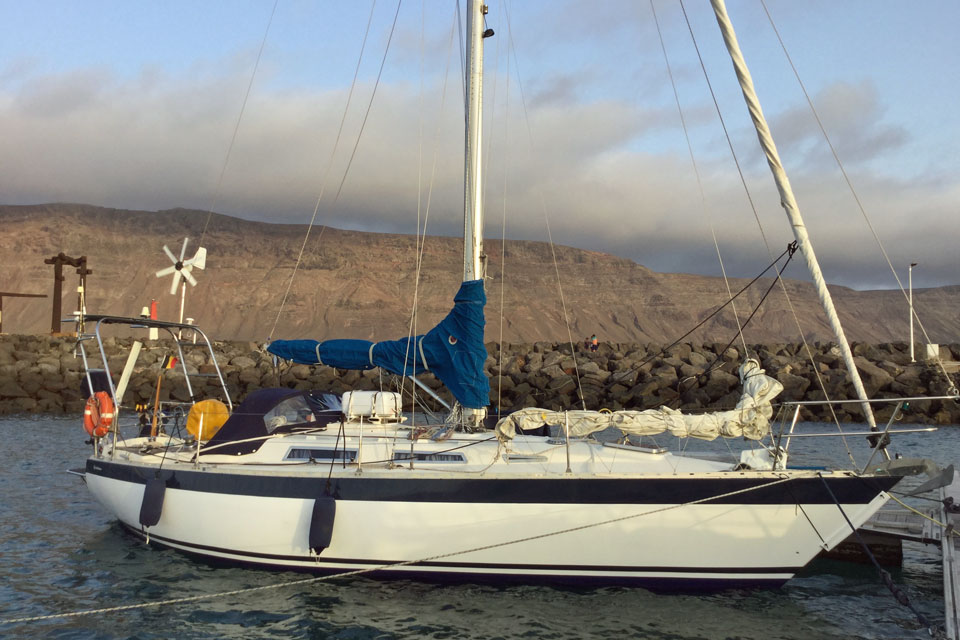 The Wauquiez Gladiateur 33
The Wauquiez Gladiateur 33
Recent Articles
-
Modern Boat Electronics and the Latest Marine Instruments
Dec 20, 25 05:27 PM
Should sailboat instruments be linked to the latest boat electronics as a fully integrated system, or is it best to leave them as independent units? -
Hans Christian 43: Classic Bluewater Cruiser & Liveaboard Sailboat
Dec 10, 25 04:37 AM
Explore the Hans Christian 43: a legendary heavy-displacement, long-keel sailboat. Read our in-depth review of its specs, design ratios, and suitability for offshore cruising and living aboard. -
Planning Your Sailboat Liveaboard Lifestyle: An Ocean Sailor's Guide
Dec 06, 25 05:18 AM
Seasoned sailors share their methodical risk analysis for planning a secure Sailboat Liveaboard Lifestyle, covering financial, property, and relationship risks.
